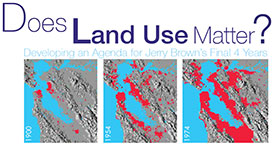2015 Environmental Symposium
Does Land Use Matter?
Developing an Agenda for Jerry Brown’s Final 4 Years
FEBRUARY 21, 2015
 At the 2015 PCL Environmental Symposium, several common themes emerged after numerous presentations and discussions. Compared to models of sustainable “Smart Growth,” California’s current, low density suburban development:
At the 2015 PCL Environmental Symposium, several common themes emerged after numerous presentations and discussions. Compared to models of sustainable “Smart Growth,” California’s current, low density suburban development:
- Emits three times more GHGs (Greenhouse Gas)
- Costs twice as much for infrastructure development and maintenance
- Consumes a third more water
- Increases traffic congestion and isolates people who cannot afford a car
- Consumes three times as much open space and agricultural land
- Increases respiratory and activity-related disease incidence and health risks by reducing physical exercise
- Reduces quality of life
“Even when controlling for income, household size and other variables, research shows that people must drive more, own more cars, breathe more polluted air, face greater risk of traffic fatalities, and walk less in places with more sprawling suburban development patterns.” [Reid Ewing, Rolf Pendall, and Don Chen, “Measuring Sprawl and Its Impact: Volume 1” (PDF), page 47]
With general agreement on the statewide challenge of too much unsustainable sprawl across California, participants worked together to create solutions. What follows is a basket filled with ideas for further discussion. At the closing session, panelists reviewed these ideas, and also identified several filters that make any action more or less difficult to get through the political process. Ideas that required a two-thirds vote, a constitutional amendment, or anything other than a simple majority vote are more difficult to pass and need a much stronger groundswell of support to be enacted. Administrative actions are less encumbered with legislative constraints, but must have firm executive backing. Litigation provides targeted opportunities, but success is not guaranteed and timeframes can be long. In this preamble, we invite you to explore these ideas, add your comments and help us build an agenda for the next four years. While many ideas were discussed, these five strategies emerged as the most voted upon during the closing symposium discussion: Land Use & Transportation.
Background
Climate change, economic reality, and shifting population demographics have created new momentum around land use and urban reform.
Regional leaders from around the state are working together to create livable communities that will also meet our targets for greenhouse gas reduction. But the job is just beginning, and the road is long.
Governor Brown has been at this task since his 1978 publication of An Urban Strategy for California. In 2015, we anticipate that once again California’s Governor will take the lead in ushering in a new set of policies to assure a sustainable future when the California @ 50 Million: California’s Climate Future is finalized. We must join with him to create a common vision for California and plan the next concrete steps forward
Let’s rebuild California in a way that improves our quality of life, enhances our economic development, and protects our environment while using our tax dollars efficiently. That will require political cooperation, smart infrastructure investments, new technologies, creative public-private partnerships, and a reexamination of existing policies that unintentionally reward counterproductive land use decisions
PCL/PCL Foundation offered a range of sessions related to how CEQA interacts with other environmental laws and policies to create a more sustainable California. In addition to offering legal credit (CLE) for attorneys for several panels we also offered certification maintenance credit (AICP) for planners.
